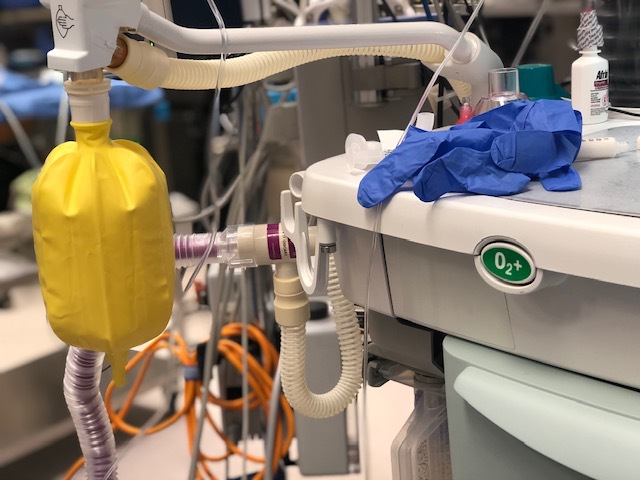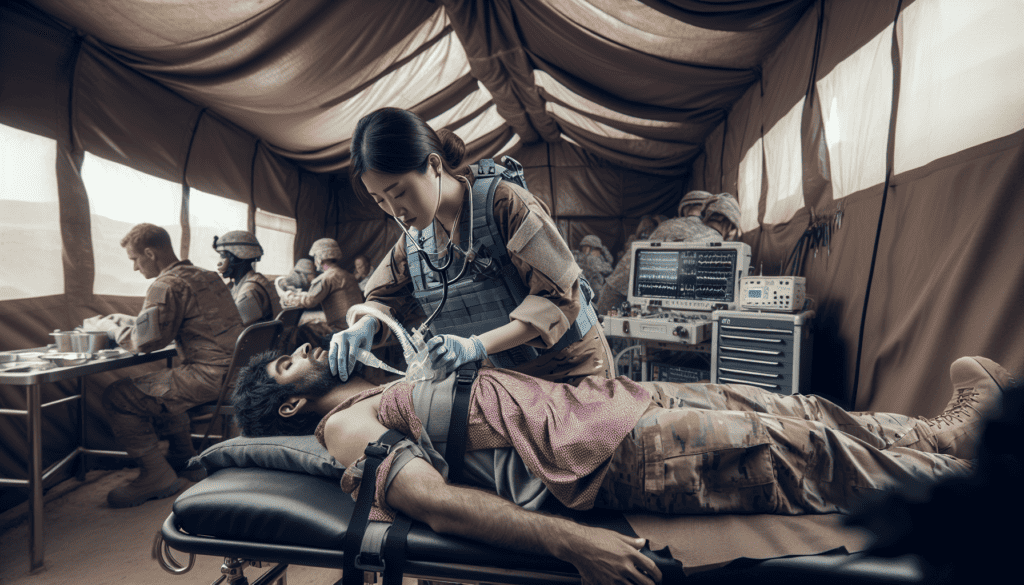Where Do CRNA’s Work? A Comprehensive Overview of Career Environments for Nurse Anesthetists
Where do CRNA’s work? These advanced practice nurses provide critical anesthesia care in settings that might surprise you – from the chaos of emergency rooms to the discipline of military facilities, and the precision of pain clinics. Our exploration highlights the versatile roles where do CRNA’s work within the healthcare mosaic, reflecting the depth and variety of their professional capacities.
Key Takeaways
- Certified Registered Nurse Anesthetists (CRNAs) work in a diverse range of medical settings including hospitals, surgical centers, outpatient facilities, obstetrical delivery rooms, pain management clinics, and military installations, where they provide essential anesthesia care.
- CRNAs have expanded their roles into non-traditional environments such as emergency rooms, trauma units, and ketamine clinics, and they often serve as the primary anesthesia providers in rural and underserved areas.
- The employment landscape for CRNAs is evolving with a growing demand for their services in various healthcare systems, and they must be prepared for a dynamic workplace through continuous education and adaptation to new settings.
Diverse Practice Settings for Certified Registered Nurse Anesthetists

Understanding the versatility of CRNAs while deciding when you should apply to CRNA School requeires a broad knowledge of Nurse Anethesist and their practice settings. CRNAs work in a variety of medical environments, each presenting unique challenges and opportunities for growth. Some common practice settings for CRNAs include:
- Urban hospitals
- Rural clinics
- Ambulatory surgical centers
- Military facilities
- Pain management clinics
In each of these settings, CRNAs play a crucial role in providing safe and effective anesthesia care to patients.
Traditional hospital surgical suites see CRNAs collaborating with surgeons and other healthcare professionals, providing safe and effective anesthesia care.
They are also found in obstetrical delivery rooms, where their expertise in pain management and emergency services is vital in childbirth.
However, the scope of a CRNA’s practice extends beyond the walls of a traditional hospital. They also work in ambulatory surgery centers, providing anesthesia for patients undergoing outpatient procedures, and outpatient care facilities, where they oversee a range of procedures from simple dental operations to complex orthopedic surgeries.
Hospitals and Surgical Centers
In hospital settings, a CRNA’s primary responsibilities encompass:
- Pre-anesthetic preparation and assessment
- Anesthesia initiation, management, and recovery
- Post-anesthesia care
- Perianesthetic and clinical support activities
CRNAs work in close collaboration with surgeons ensuring the safe and effective administration of anesthesia.
CRNAs are involved in a wide array of surgical procedures, from routine dental surgeries to complex orthopedic operations. They work alongside surgeons to prepare patients for surgery and provide essential anesthesia care.
This collaborative effort ensures the best possible patient outcomes, reinforcing the importance of CRNAs in the healthcare team.
Ambulatory Surgery Centers
CRNAs also significantly contribute to ambulatory surgery centers, not just traditional hospital settings. These centers specialize in outpatient procedures, and CRNAs are integral to their operation.
They provide comprehensive anesthesia-related care for various surgical, diagnostic, and therapeutic procedures. Whether it’s a simple endoscopy or a more complex orthopedic surgery, CRNAs are there to ensure patient safety and comfort.
The role of a CRNA in an ambulatory surgery center extends beyond the operating room. They are also involved in the patient recovery process, selecting specific anesthetic agents and techniques to promote swift recovery.
This careful orchestration of care ensures that patients can return home as soon as possible after their procedures, highlighting the integral role of CRNAs in these settings.
Outpatient Care Facilities
Outpatient care facilities demand a CRNA’s focus to be majorly on routine procedures. Here, they are responsible for providing pain medication (anesthesia) care before, during, and after surgery, while closely monitoring patients.
The nature of these settings requires CRNAs to possess a specific set of skills to proficiently handle the unique demands of outpatient care.
These facilities often utilize ambulatory anesthesia for minor procedures that do not require an overnight stay. This type of anesthesia is tailored to minimize recovery time, allowing patients to be discharged earlier following their procedures.
In these environments, CRNAs play a crucial role in ensuring a smooth and efficient patient care experience.
The Role of CRNAs in Specialty Areas

The practice of CRNAs is not confined to general anesthesia. They also specialize in various medical fields, providing tailored anesthesia care to meet specific patient needs.
These specialty areas include obstetrical delivery rooms, dental offices, and plastic surgery practices, all of which require a unique set of skills and expertise.
In obstetrical delivery rooms, CRNAs collaborate patients to come up with a plan that will effectively manage and alleviate pain during childbirth. Their role in these settings is pivotal, ensuring the safety and comfort of both mother to allow for a pleasurable birthing process.
Meanwhile, in dental offices and oral surgery clinics, CRNAs play a significant role in delivering anesthesia and analgesia across various practice settings. Whether it’s for a routine dental cleaning or a complex oral surgery, their expertise ensures patient comfort and safety.
Obstetrical Delivery Rooms
In obstetrical delivery rooms, CRNAs play a key role in managing labor pain and facilitating smooth deliveries.
They typically administer analgesia for labor pain and anesthesia for surgical procedures such as cesarean sections.
This dual role ensures that mothers are comfortable and safe during one of the most important moments of their lives.
The responsibilities of a CRNA in an obstetrical delivery room include:
- Assisting with the delivery process
- Monitoring the mother’s vital signs
- Administering anesthesia as needed
- Managing pain during labor
- Ensuring the safety and well-being of both the mother and baby
- Collaborating with the obstetrical team to provide the best possible care
This collaborative effort reinforces the importance of CRNAs in these life-changing moments.
Dental Offices and Oral Surgery Clinics

In dental offices and oral surgery clinics, CRNAs play a crucial role in patient care.
Whether it’s for a routine dental cleaning or a complex oral surgery, their skills and expertise are invaluable.
They provide anesthesia and analgesia for various dental procedures and surgeries, ensuring patient comfort and safety at all times.
But the role of a CRNA in these settings extends beyond the operating room. They also work closely with the dental team, overseeing sedation or anesthesia services and enabling each team member, including surgeons and dentists, to focus on their respective responsibilities.
This collaborative effort ensures a seamless patient experience, highlighting the importance of CRNAs in these settings.
Plastic Surgery Practices
In the field of plastic surgery, CRNAs play a key role in patient care. They work closely with plastic surgeons, providing anesthesia for a range of cosmetic and reconstructive procedures. This collaboration ensures optimal patient outcomes, reinforcing the importance of CRNAs in these settings.
But the role of a CRNA in a plastic surgery practice goes beyond the operating room. They also play a crucial role in patient recovery, selecting specific anesthetic agents to promote swift healing and minimize discomfort. Through their expertise and collaboration with surgeons, CRNAs ensure a smooth and efficient patient experience.
Nurse Anesthesia in Non-Traditional Roles

Beyond the conventional healthcare settings, CRNAs also serve in non-traditional roles, expanding their scope of practice and contributing to diverse healthcare environments.
These roles include positions in the military, emergency rooms, and ketamine clinics, all of which require a unique set of skills and expertise.
In the military, for instance, CRNAs provide general anesthesia and critical care to service members. They exercise full practice authority in all branches of the military and deliver essential services on the front lines, navy ships, and in aircraft evacuation teams worldwide.
Meanwhile, in emergency rooms and trauma units, CRNAs manage airways, provide anesthesia, and offer critical care support to patients with life-threatening injuries and illnesses.
They also work in ketamine clinics and pain management centers, offering specialized anesthesia services for patients with chronic pain and mental health conditions.
Military and Armed Forces
In the military and armed forces, CRNAs play a crucial role in providing high-quality anesthesia care. They serve as the primary providers of anesthesia care to U.S. military personnel, both on the home front and in combat zones. Their expertise is essential in ensuring the health and wellbeing of those who serve our country.
CRNAs in the military are also involved in a wide range of medical procedures. From routine surgeries to emergency medical care, they are trained to handle a multitude of situations. This versatility and capability make them an invaluable asset to the military healthcare team.
Emergency Rooms and Trauma Units
In emergency rooms and trauma units, the role of a CRNA is paramount. Their skills are often the first ones called upon when a complex airway issue arises and provide immediate anesthesia care while managing complex airways in critical situations.
Their skills in fast-paced, high-pressure environments make them an integral part of the emergency medical team.
CRNAs in these settings are also involved in providing critical care support to patients experiencing life-threatening injuries and illnesses. They utilize their specialized knowledge in anesthesia, resuscitation, and airway management to effectively handle these critical situations.
Their presence in emergency rooms and trauma units is crucial in ensuring patient safety and survival.
Ketamine Clinics and Pain Management Centers
In ketamine clinics and pain management centers, CRNAs offer a unique subset of anesthesia services. They administer ketamine for sedation, general anesthesia, and infusion therapy for chronic pain and mental health conditions.
This specialized care has proven effective in treating a variety of conditions, highlighting the versatility of CRNAs.
CRNAs working in pain management centers employ a variety of approaches to effectively manage and address chronic pain. This includes:
- Interventional modalities
- Psychological modalities
- Therapeutic approaches
- Physiological approaches
- Pharmacological approaches
All of these approaches are tailored to meet the unique needs and conditions of each patient. Through their expertise, CRNAs can help patients regain control of their lives and find relief from chronic pain.
Advancing Nurse Anesthesia Practice in Rural Settings

In rural settings, CRNAs play a pivotal role in providing essential healthcare services. They often serve as the only anesthesia providers in these communities, ensuring access to quality care for all patients.
Their presence in these areas is not only essential for patient care but also critical for the advancement of nurse anesthesia practice in these settings.
The role of a CRNA in a rural setting is multifaceted. They not only provide anesthesia services but also collaborate with general surgeons to provide effective healthcare leadership. This collaboration is crucial in ensuring the availability of surgical care and improving overall patient outcomes in these communities.
Career Opportunities Beyond Clinical Practice
A range of career opportunities can be explored by CRNAs beyond clinical practice. Some of these opportunities include:
- Roles in education
- Healthcare administration
- Research
- Policy and advocacy
- Consulting
This versatility is a testament to the diverse skill set and expertise that CRNAs and registered nurses bring to the healthcare field.
In the field of education, for instance, CRNAs can serve as faculty members in nurse anesthesia programs, guiding the development of aspiring nurse anesthetists. They can also transition into managerial or administrative positions in hospitals or healthcare organizations, influencing healthcare decisions and policies.
These opportunities allow CRNAs to contribute to the advancement of the nursing profession in ways that extend beyond direct patient care.
The Evolving Landscape of CRNA Employment
The landscape of CRNA employment is constantly evolving, with new practice settings and opportunities emerging as healthcare systems adapt to changing patient needs and technological advancements.
Over the past decade, there has been substantial growth in the number of trained CRNAs, with even more growth projected in the coming years.
These changes in the employment landscape are influenced by various factors, including job availability, growth potential, and the ongoing shortage of anesthesia providers.
As healthcare systems continue to evolve, CRNAs will continue to play a pivotal role in delivering high-quality anesthesia care to patients in a variety of settings.
Compensation and Benefits Across Different Practice Environments
Across different practice environments, the compensation and benefits of CRNAs vary. Factors such as geographic location, experience, and specialty can influence salary and benefits packages.
For instance, areas with a shortage of CRNAs may offer higher salaries to attract and retain talent. Similarly, urban areas and states with higher living expenses tend to offer higher salaries to align with the increased cost of living.
Aside from salary, CRNAs also receive a range of benefits, including health insurance, disability insurance, and dental insurance. These benefits, coupled with the rewarding nature of the work, make the profession of a CRNA a fulfilling career choice for many aspiring healthcare professionals.
Preparing for a Dynamic Workplace as a Future CRNA
With the continuous evolution of the field of nurse anesthesia, aspiring CRNAs must gear up for a dynamic workplace.
This involves pursuing advanced education, such as obtaining a doctoral degree, relevant certifications, and gaining diverse clinical experiences through nurse anesthesia educational programs. In addition, passing the national certification examination will ensure that future CRNAs are equipped with the skills and knowledge needed to excel in various practice settings, including those that involve working with advanced practice registered nurses and advanced practice nurses.
Aspiring CRNAs must also be prepared to engage in lifelong learning. The field of nurse anesthesia is constantly evolving, and staying abreast of the latest research and best practices is crucial for providing the highest quality of care to patients.
By staying committed to their professional development and enrolling in a nurse anesthesia program, future CRNAs can ensure that they are well-prepared to navigate the dynamic landscape of nurse anesthesia practice.
Summary
In conclusion, the role of Certified Registered Nurse Anesthetists is multifaceted and extends far beyond the operating room.
Whether they’re providing anesthesia for a routine dental procedure or assisting in a complex surgical operation, CRNAs play a crucial role in patient care. Their expertise and skills are invaluable in a wide range of healthcare settings, from traditional hospitals to non-traditional environments like the military and ketamine clinics.
As the healthcare landscape continues to evolve, so too will the roles and responsibilities of CRNAs. With advancements in technology and changes in patient needs, CRNAs will continue to be an integral part of the healthcare team.
Whether you’re an aspiring CRNA or a patient seeking care, one thing is clear: the impact of CRNAs on the healthcare system is undeniable.
Frequently Asked Questions
Where do most nurse anesthetists work?
Nurse anesthetists work in various settings such as hospitals, surgical clinics, doctors’ offices, and outpatient care centers. They can also work in the military, the education field and hospital administration.
What can a CRNA do besides anesthesia?
CRNAs can become educators, teaching future nurse anesthetists and serving as program directors to advance the profession. This allows them to contribute to the quality of care in the field of nurse anesthesia.
Can you own your own practice as a CRNA?
Yes, you can own your own CRNA practice.
What does a CRNA do on a daily basis?
A CRNA monitors patients during surgery, administers drugs before anesthesia, manages patients’ airways, and closely monitors their physical reaction to drugs. They also maintain vigilance to recognize and respond to any change in patient condition and collaborate with the healthcare team for individualized anesthesia plans.
What are the primary responsibilities of CRNAs?
The primary responsibilities of CRNAs include delivering anesthesia, ensuring patient comfort, providing pain management, and delivering emergency services such as airway management during surgical, diagnostic, and obstetrical procedures.
Where can I find out more about the CRNA Career?
The governing body for Nurse Anethesist is the American Association of Nurse Anesthesiology (AANA) and they have lots of valuable information about becomeing a Nurse Anesthesiologist over at AANA
